39 bloodborne pathogens signs and labels
Bloodborne Pathogens - Hazard Communication - OSHAcademy free online ... 3. Which of the following topic need NOT be presented during bloodborne pathogens training? a. signs, labels, and color-coding used on containers b. progressive disciplinary procedures for noncompliance c. types, proper use, location, removal, handling, decontamination, and disposal of PPE d. the procedure to follow if an incident occurs. Next ... Signs and Labels | Occupational Health and Safety Manual Warning labels are placed on containers used to store or transport blood or OPIM, including biohazardous waste bags, sharps containers, refrigerators, freezers, and incubators. The label will be a fluorescent orange, red, or orange-red biohazard label as illustrated with lettering in a contrasting color (see example below).
PDF Bloodborne Pathogen Protection Program Bloodborne pathogens are an existing or potential health hazard within an agency, or agency personnel exposure during the course of work. Bloodborne pathogens are ... • Signs and labels and/or color coding : Bloodborne PathogenProtection Program Element R2-10-207(11)(m) Page 4 of 5 June 2015: Are there specific

Bloodborne pathogens signs and labels
Bloodborne Pathogens Exposure Control Plan | Missouri labor This sample Bloodborne Pathogens program is provided by the Missouri On-Site Safety and Health Consultation Program. In order to comply with OSHA's standard for Bloodborne Pathogens, 29 CFR 1910.1030, this written program must be site specific. ... An explanation of the signs and labels and/or color coding required by the standard and used at ... Bloodborne Pathogens | Environment, Health and Safety For Diagnostic all personnel using human or non-human primate derived materials in their diagnostic activities will follow their area specific SOP (s) For non-emergency and non-lab related biological spills please call Cornell Customer Service at 607-255-5322 or submit a Maximo request. Bloodborne Pathogens: A Safety Guide - Zing Green Products For a bloodborne pathogen to cause an infection or disease, four conditions must be met: 1. A pathogen must be present in an exposure to bodily fluids. 2. There must be an entry site for the pathogen (usually through a mucous membrane or broken skin) 3. The pathogen must enter the body in sufficient concentration to overwhelm immune response. 4.
Bloodborne pathogens signs and labels. Bloodborne Pathogens - Overview | Occupational Safety and Health ... Bloodborne pathogens are infectious microorganisms in human blood that can cause disease in humans. These pathogens include, but are not limited to, hepatitis B (HBV), hepatitis C (HCV) and human immunodeficiency virus (HIV). Needlesticks and other sharps-related injuries may expose workers to bloodborne pathogens. PDF Bloodborne Pathogens - Wa Lesser known Bloodborne Pathogens Lesser known BBPs include: - Syphilis - Babesiosis - Brucellosis - Leptospirosis - Arboviral infections - Relapsing fever - Creutzfeld-Jakob Disease - Human T-lymphotrophic virus Type I - Viral Hemorrhagic Fever Leptospira bacteria in kidney tissue Brucellosis bacteria Bloodborne Pathogens - OPIM Labeling | Bloodborne Pathogens Training Class The Bloodborne Pathogens Standard is used to disclose potential hazards, so ensure you use the proper labels and signs to communicate hazards to workers (see example images). The right warning labels must be attached to these containers: Containers for contaminated reusable sharps Regulated waste Freezers and fridges housing OPIM or blood Bloodborne Pathogen Stickers - Compliance Signs BLOODBORNE PATHOGENS TRAINED LDRE-18916 Quick add BLOODBORNE PATHOGENS TRAINED LDRE-19157 Quick add BLOODBORNE PATHOGENS TRAINED LDRE-19296 Quick add Don't see what you need? Contact our live, US-based sales team at (800) 578-1245 or by e-mail. 1 Expand your search to see results that contain some of your words
Bloodborne Pathogens | Environment, Health and Safety Environment, Health and Safety. 395 Pine Tree Road, Suite 210 Ithaca, NY 14850. Front Desk: (607) 255-8200 Contact EHS PDF Bloodborne Pathogens - Atrium Health Signs and symptoms include: • Mild flu-like symptoms • Fatigue • Nausea • Loss of appetite • Stomach pain • Jaundice (yellowing of the skin and eyes) • Darkening of the urine ANNUAL COMPLIANCE EDUCATION Bloodborne Pathogens Blood contact is not the only way to spread pathogens. USG: RTK Introduction to Bloodborne Pathogens Signs, Labels & Color Coding Signs and labels in the workplace communicate bloodborne pathogen hazards to employees. The warning label must include the universal biohazard symbol and the term "biohazard" in a color that contrasts with the fluorescent orange, orange-red background, as illustrated to the right: Bloodborne Pathogens (BBP) Kit Inside Label Sign - amazon.com Bloodborne pathogens sign includes critical information on whereabouts of BBP kit. Printed with UV inks and "anti-graffiti" UV top coating. OSHA safety sign designed for light-duty indoor/outdoor applications: reliable adhesion to difficult substrates with a service temperature range of -40˚F to +200˚F.
Bloodborne Pathogen Labels - Accuform Place Bloodborne Pathogen Labels anywhere in your workplace to alert employees about biohazards they may be subjected to, including infectious needles, waste, and serious hazards. Ensure others are protected and informed with Bloodborne Pathogen Labels. Use Bloodborne Pathogen Labels to guard others from direct contact with blood and bodily fluids. PDF OSHA Bloodborne Pathogens - scccmh.org Although you may not have any symptoms, common symptoms include: fever, fatigue, loss of appetite, nausea, vomiting, abdominal pain, dark urine, clay-colored bowel movements, joint pain, and/or jaundice. These symptoms usually occur six to seven weeks following exposure, but may appear as early as two weeks or as long as six months after exposure. Bloodborne Pathogens - ISSA Specifically, information concerning the hazards associated with bloodborne pathogens should be communicated through the use of warning labels, biohazard signs, and employee training. OSHA generally does not consider maintenance personnel and janitorial staff employed in non-health care facilities to have a foreseeable exposure to bloodborne ... Bloodborne Pathogens Blood-Borne Pathogens Program (Exposure Control Plan) Effective Date: Revision Date: Revision #: RELATED LEGISLATION: North Carolina Occupational Safety and Health Standards for General Industry, 29 CFR 1910.1030. A. Purpose. ... Labels and Signs (Name of position/person)
Bloodborne Pathogens - Cabrillo College Labels and Signs. One of the most obvious warnings of possible exposure to bloodborne pathogens is a biohazard label. Therefore, warning labels must be affixed to containers of regulated waste, refrigerators and freezers containing blood or other potentially infectious materials, and other containers used to store, transport or ship blood or ...
Bloodborne Pathogens | Montgomery College, Maryland As defined in the Standard, "Bloodborne Pathogens means pathogenic microorganisms that are present in human blood and can cause disease in humans. These pathogens include, but are not limited to, hepatitis B virus (HBV) and human immunodeficiency virus (HIV)." ... Use Hazard Labels and Signs. Warning labels must be affixed to containers of ...
Bloodborne Pathogens | Sacramento State Symptoms of AIDS infection can vary, but often include weakness, fever, sore throat, nausea, headaches, diarrhea, a white coating on the tongue, weight loss, swollen lymph glands and eventually death.
Biohazards & Bloodborne Pathogens Signs alert others. Biohazards & Bloodborne Pathogens Refine by No filters applied Sort By: Accuform Warning - Infectious Waste Hazard $12.46 - $32.86 Choose Options Quick view Accuform Biohazard Sign $6.02 - $12.20 Choose Options Quick view Accuform Infectious Waste Notify Public Health Authority In Case Of Damage Or Leakage (W/Graphic) $12.46 - $32.86 Choose Options
PDF Appendix Xv Bloodborne Pathogens - Msm Bloodborne pathogen shall refer to pathogenic microorganisms that are present in human blood and can cause disease in humans. These pathogens shall include, but are not limited to hepatitis B virus (HBV), hepatitis C virus (HCV)and human immunodeficiency virus (HIV). 2.
PDF Proper Recordkeeping, Labeling, and Signage for Bloodborne Pathogens ... Proper Recordkeeping, Labeling, and Signage for Bloodborne Pathogens* Potential Hazard - Recordkeeping Lack of information to adequately implement a bloodborne pathogens program or address bloodborne pathogen hazards. Possible Solutions Employer should establish and maintain both medical and training records [29 CFR 1910.1030(h)(1) and 29 CFR 1910.1020].
PDF Bloodborne Pathogens - Occupational Safety and Health Administration Bloodborne Pathogens Bloodborne pathogens are microorganisms that are transmitted through the bloodstream. The viruses that cause Hepatitis B Virus (HBV) and Human Immuno- ... An explanation of the signs and labels and/or color coding required by 29 CFR 1910.1030(g)(1)
Bloodborne Pathogens The hazards of bloodborne pathogens must be communicated to employees through: Signs; Labels; Training. The Bloodborne Pathogen Standard requires that warning labels be attached to: ... The warning label must include the universal biohazard symbol followed by the term "BIOHAZARD" in a fluorescent orange or orange-red color with lettering or ...
USG: RTK Introduction to Bloodborne Pathogens Bloodborne Pathogens. Transmission of Bloodborne Pathogens. Exposure Control Plan. Methods of Compliance. Engineering and Work Practice Controls. Personal Protective Equipment. Signs, Labels, and Color-Coding. Response to Emergencies Involving Blood or Body Fluids. Housekeeping and Waste Disposal.
Bloodborne Pathogen Signs - Accuform Bloodborne Pathogen Signs. Bloodborne Pathogens are an occupational hazard for employees who may be exposed to blood and other potentially infectious materials in hospitals, doctor's offices, and clinics, to name a few. OSHA's Bloodborne Pathogens standard 29 CFR 1910.1030, prescribes safeguards to protect workers against the health hazards ...
Bloodborne Pathogens: A Safety Guide - Zing Green Products For a bloodborne pathogen to cause an infection or disease, four conditions must be met: 1. A pathogen must be present in an exposure to bodily fluids. 2. There must be an entry site for the pathogen (usually through a mucous membrane or broken skin) 3. The pathogen must enter the body in sufficient concentration to overwhelm immune response. 4.
Bloodborne Pathogens | Environment, Health and Safety For Diagnostic all personnel using human or non-human primate derived materials in their diagnostic activities will follow their area specific SOP (s) For non-emergency and non-lab related biological spills please call Cornell Customer Service at 607-255-5322 or submit a Maximo request.
Bloodborne Pathogens Exposure Control Plan | Missouri labor This sample Bloodborne Pathogens program is provided by the Missouri On-Site Safety and Health Consultation Program. In order to comply with OSHA's standard for Bloodborne Pathogens, 29 CFR 1910.1030, this written program must be site specific. ... An explanation of the signs and labels and/or color coding required by the standard and used at ...





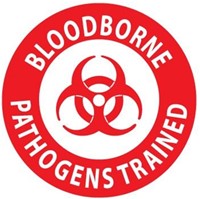
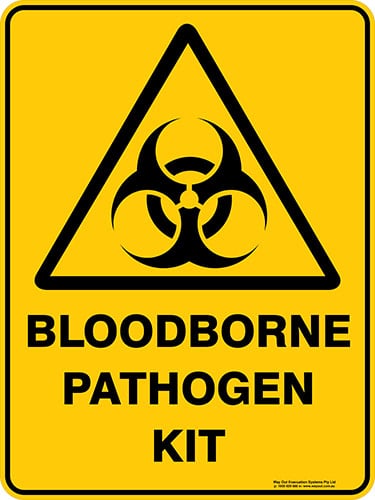
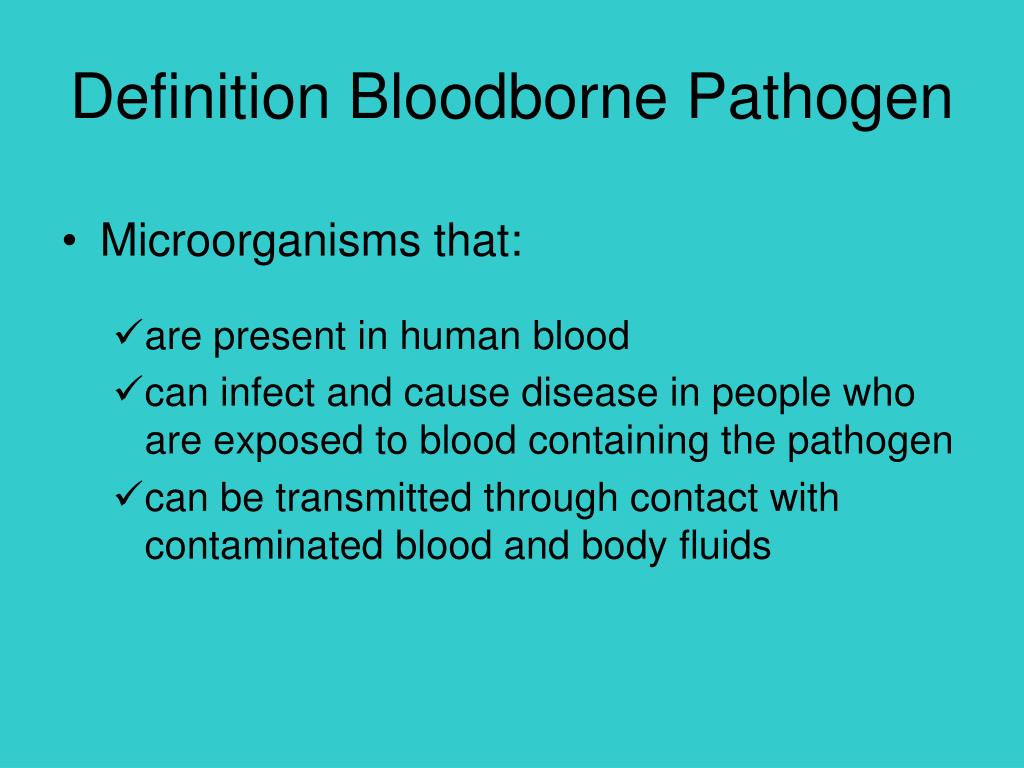

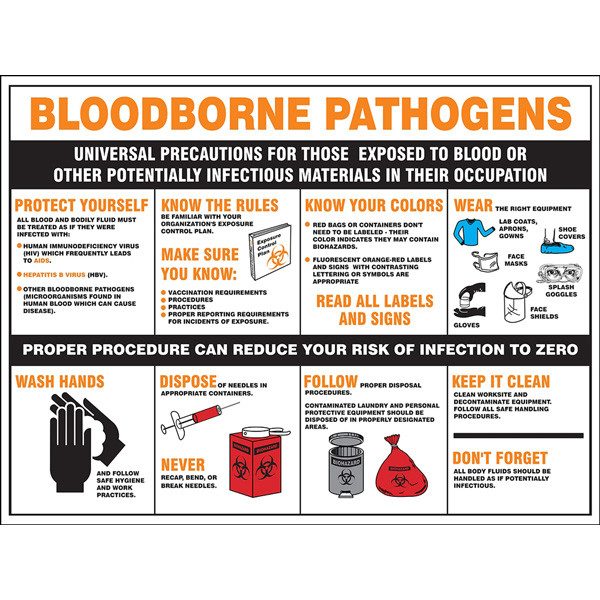

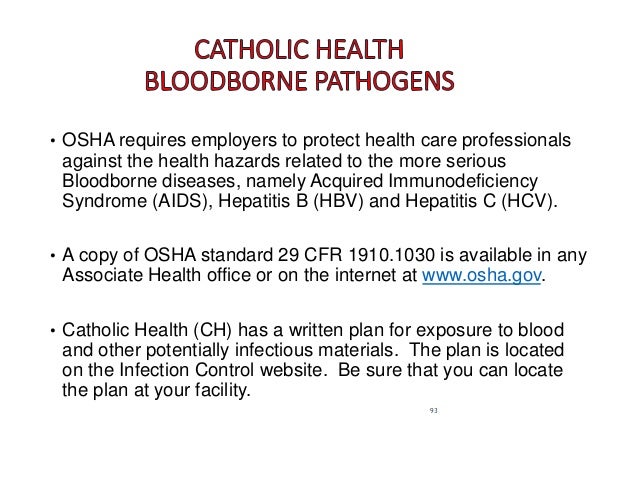
Post a Comment for "39 bloodborne pathogens signs and labels"